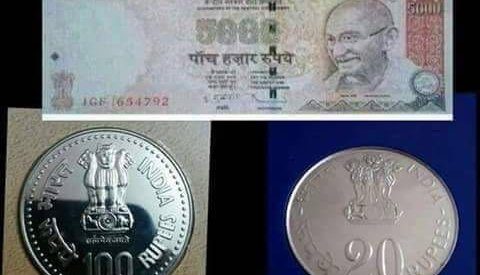This is not a confirmation of any news but I received it as a message on Whatsapp about introduction of new currency by RBI. After giving some thought to it, I decided to write an article about Indian currency. If India is launching new and higher denomination of currency such as INR 5000, It is hiding the growing inflation in domestic economy. In this blog, we shall understand how the rising inflation is to blame for rising denomination of currency.
When a currency of lower denomination is introduced in the economy, it exchanges more hands as compared to a currency with higher denomination. A one rupee note or coin (INR Re.1/-) which circulates into hands of 100 citizens is much better for an economy than fifty rupees ( INR Rs.50/-) circulating into the hands of just 2 persons. Hence, lower the denomination of currency in the economy, the more is its circulation in the economy.
For a country like India with a population of 1.25 billion with a large portion of population living in acute poverty, there would be maximum circulation of currency when citizens buy day-to-day necessities of life for which currency up to a denomination of Rs. 50 suffice for many purposes like buying daily groceries, etc. Huge denominations of currency generally exchange the hands of citizens with huge amount of transactions such as real estate investments, big monetary deals which makes it difficult to be done with lower monetary denomination of currency as a cash transaction. These transactions, if done, with check payment or bank transfers, does not create any black money in the economy. However, If these transactions are done in cash so as to pay black money to the other party, the higher denomination of currency plays a very useful role for that purpose.
Thus, the disadvantage of introducing these huge denomination currencies is that they exchange very few hands in the economy and the money with the affluent sections of society generally remains with the affluent and does not circulate in rest of the economy. In this way, currencies in huge denomination not only generates more black money in the economy but it also increases economic disparity further in the economy. This way huge denomination of currency proves to be inflationary for an economy.
Introducing such huge denominations of currency not only hides the rising inflation but it generates more black money to help the already wealthy individuals in the country. Now, Politics is neither my hobby nor my passion but as an economist, when I see every political party make big promises about eliminating poverty from India but when they follow policies which are contrary to their promises, I think citizens need to be aware of their policies. On 3 July 2016, I had published the following article on LinkedIn and I want the reader to read it before reading any further.
Modi government policies are creating more Black money in India than what it can collect from Abroad
If RBI wants to introduce currency with such huge denomination, I find it ridiculous that RBI’s claim that their policies are actually targeted towards reducing inflation. Instead, RBI should take away currencies of higher denominations such as INR 1000 and INR 500 from domestic economy.
Only under such circumstances can RBI policies and hence government policies be considered to be Anti-Inflationary and pro-poor. The reduction of black money from Indian economy would come as a bonus with these ideas. Whether or not Hon. Prime Minister Narendra Modi is successful in bringing back black money of Indians that is stashed abroad, Our Prime Minister would do Indians a great favor by avoiding creation of more black money in Indian economy with my suggested policies.


Recent Comments